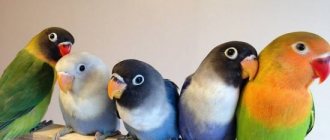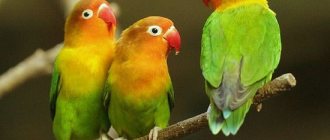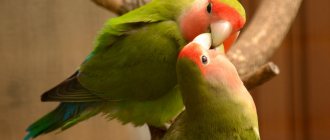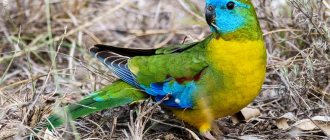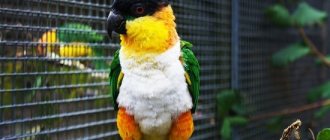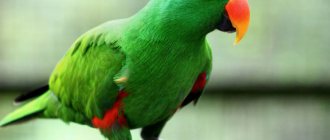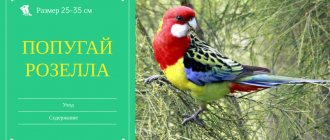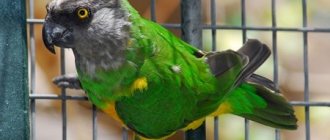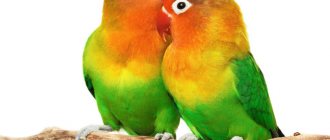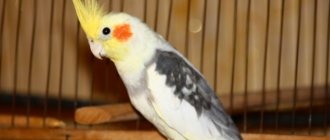Small birds are especially valued as pets, and lovebirds rightfully occupy one of the top lines of the unofficial rating. Colorful appearance, unpretentiousness, love of life, endurance - African parrots possess all these qualities. The keeping and breeding of lovebirds has characteristic features. Let's learn more about this, but first, let's take a closer look at the charming birds: consider their appearance and lifestyle in the wild, talk about the intricacies of care, and also don't forget about disease prevention.
Appearance
The lovebird can be called one of the most colorful parrots. Its plumage always contains several bright shades, creating an attractive image. Depending on the species, the birds are colored differently: for example, the most popular rosy-cheeked lovebird has a green base color, a red crown, and pink cheeks and neck. Females and males are very similar to each other; It is difficult to distinguish gender by appearance.
Description of the parrot:
- length from beak to tail does not exceed 20 cm;
- weight 35 – 60 g;
- the head is large;
- the body is well-fed;
- paws short, stable;
- the wings are compact, barely reaching the neat rounded tail.
This is interesting! Lovebirds have a peculiarity: the unfeathered area around the eye socket is often white, making the eyes appear larger and more expressive.
The beak is thickened, curved, strong. Its shades vary: in some subspecies the beak color is rich red or orange, in others it is light gray or straw yellow. Young birds have a black mark on the base of the beak, which decreases as the parrot matures, and the color of the cornea becomes uniform.
To describe in detail the appearance of these parrots, let us turn to the scientific classification and consider especially interesting specimens individually.
Types of lovebirds
In nature, there are nine species of lovebirds:
- Rosy-cheeked;
- Fisher's lovebird;
- Masked;
- Liliana's lovebird;
- Collared;
- Blackwing;
- Red-faced;
- Grey-headed;
- Black-cheeked.
The most common among pet parrot lovers are rosy-cheeked lovebirds. They are most adapted to living in a cage or enclosure and easily reproduce in captivity. They have a higher survival rate. These cute birds are characterized by grass-green plumage. The main part of the body is covered with feathers in green tones: the back, abdomen, wings and tail. The head is bright red, the feather cover gradually becomes lighter, moving from the neck to the sternum. Between the wings there is a blue stripe of feathers. Based on this species, breeders have developed several color options: lutino, cremino, spotted and others.
Popular ones include Fischer's lovebirds - hardy, sociable, and easily tamed. The natural color is green, while the head is orange with a brown crown, the chest is yellow, and the middle of the tail is bluish. When birds belonging to different species are crossed, beautiful offspring are obtained: white parrots, yellow parrots, blue parrots.
Masked lovebirds
Another species often found in captivity is the masked one. It is a showy bird with a black head, with distinct white eye rings. The natural color of a parrot: the back, wings, abdomen and tail are green, the head is black, the neck and chest are yellow. The beak is red. Using this species as the main one, breeders developed new color mutations. There are individuals of cobalt, turquoise and even the rarest black color.
On a note! The beauty and outward peacefulness of lovebirds is deceptive: these birds are by nature very smart, aggressive, and cunning. They know how to achieve goals and find solutions in rather difficult situations.
Small parrots are able to survive and reproduce in difficult conditions, so the number of lovebirds in nature does not decrease.
Lifestyle and behavior
The habitat of lovebirds is southwest and southeast Africa, as well as the island of Madagascar. Birds prefer to settle near bodies of water, choosing dense subtropical forests or sparse steppe areas. On the hot continent, trees and shrubs bear fruit all year round, so parrots do not lack food.
Lovebirds live in small flocks, within which they form married couples. There are frequent cases of hostility between neighboring “clans” over territory. At night, the bird community hides in the treetops, and at dawn flies out in search of food. Parrots move quite easily, both through the air, along tree trunks, and on the ground. Birds are strong - they can travel many kilometers looking for a source of food.
With the onset of the nesting season, the female looks for a suitable hollow or termite mound and arranges a place for laying. After mating, the bird produces 3–9 eggs, which it incubates for three weeks. The offspring are under care for 2–3 months, and the male does not leave the family, but carefully feeds the chicks along with the female. After the young fly out of the nest, the female begins to prepare for the next clutch.
Development of chicks by day
On the first day, the chick appears absolutely helpless. His parents feed him. After a week (and a few more days) his eyes will open, a few more days promise complete growth of fluff. Along with the down, the rudiments of future feathers will appear. At this time, the baby is considered more or less strong, but the owner still cannot touch him - he is too fragile.
Another week passes in the active development of the future feather cover. The embryos of the flight and tail feathers “sprout” and enlarge, the cover feathers are just emerging, and from them a kind of “stump” appears. The entire skin of the parrot turns out to be covered with these “stumps”, thanks to which the bird resembles a hedgehog.
The next seven days will end with the flight and tail feathers becoming fully developed. The integumentary covers will continue to develop. After a month has passed since its birth, the parrot will be completely covered with real feathers.
After a month has passed, the bird is considered completely strengthened. The parrot leaves the nest and is ready for independent life. Nevertheless, for another two weeks the parents will bring food to each chick in their beaks.
How long do lovebirds live?
In nature, it is difficult to track the lifespan of birds, but there are assumptions about parrots based on the observations of naturalists. The average lifespan of wild lovebirds is approximately 3 years. The early death of small parrots is associated with environmental conditions:
- an abundance of enemies - birds of prey, snakes, animals;
- natural disasters – heavy rains, drought;
- fires.
Pets are much luckier: they are under the protection of their owners and are less susceptible to external factors. With good care, parrots live in captivity for 12–15 years.
Behavioral features
It is worth noting the aggressiveness of birds towards birds of other species. With their large, strong beak, lovebirds are capable of causing serious injuries to neighbors when kept together. This behavior is especially pronounced during the breeding season. Having a very loud voice, in captivity lovebirds still behave quietly; they do not scream in vain.
The habits of wild females of some subspecies during nest construction are interesting. The bird carries blades of grass and twigs, inserting them between the feathers on its chest, lower back, and wings. This method of transporting materials makes the parrot look like a flying haystack.
Features of parrot behavior
Buying a parrot
Getting a small feathered pet is not difficult - just go to a pet store and choose a bird. As an alternative, there are online stores where you can order a rare breed with a spectacular color. In bird nurseries, various parrots are bred, including lovebirds, ringed, and vaccinated. This option is the most reliable in terms of bird health. You should not buy a parrot at the market, as there is a risk of bringing home a sick individual.
Before choosing, you need to find out everything about lovebirds and decide whether to buy one pet or several. If the bird lives alone, it will need more attention. Compared to other species of parrots, lovebirds are better at keeping themselves occupied, but they cannot do without human interaction. Experienced breeders recommend purchasing an already established pair or first taking one female, and after a while choosing a companion for her. Two pets will not get bored, but for this purpose it is preferable to place them in a common cage, so the interaction will be more fruitful.
It is important to know! Lovebirds do not get along with birds of other species. Defending their personal space, parrots start fights in which they can cause serious injury to their opponent. Negative character traits clearly manifest themselves during the breeding season: at this time, the female and male must be moved away from their neighbors into a separate cage.
Character
In relation to humans, birds demonstrate friendliness, sociability, and loyalty. They wait for the owner to return from work and sincerely rejoice at his arrival. Lovebirds have a lively character, are very active, curious, love to climb the bars of the cage, perches, rungs and play.
Read also
Is it possible to give a parrot roasted seeds?
When choosing a partner, they are guided by the presence of sympathy for an individual of the opposite sex. They are monogamous, create a pair for life, show care for their significant other, as well as for their offspring. However, these parrots are quite cocky and aggressive towards other birds. They zealously defend their own territory from both strangers and relatives.
Character of a lovebird parrot
Cage structure
Birds spend most of the day in a cage, and therefore the choice of housing for pets must be taken responsibly. Although lovebirds are small, they will not be able to stay in close quarters all the time. Based on this, the dimensions of the cage should be at least 40*50*80 cm, if one bird is taken into account. The more parrots, the larger the cage you will need.
It should be remembered that a pet can stick its head into the space between the bars and suffocate. It’s better if this distance is 1.5 cm - it’s safer. With their strong beak, lovebirds try to gnaw everything around. The material from which the cage is made has special requirements: non-toxicity, strength. Birds often die after being poisoned by particles of low-quality alloys.
For ease of cleaning, a removable or pull-out tray is desirable. Its surface is covered with writing paper and non-woven towels. It’s good if there is an insert made of organic glass along the perimeter of the cage in its lower part - it will be able to hold debris. The door should always be kept tightly closed, and the pet should only be released under supervision. Toys and devices should be placed inside the cage so that the parrot does not get entangled in ropes, swings, or rings.
Nest building
Lovebirds begin to build nests. During this period, they may have problems, since during the process of domestication, most of them partially lost their construction skills.
Based on this, birds can be divided into three groups: 1. Birds that enjoy construction. They do not encounter any significant problems during the process; they cope with their task quickly and just as quickly begin laying. 2. Those parrots who incorrectly fill the nest box with branches and, in the end, it turns out that there is no longer enough space for them. 3. And the last type is birds that lay down a number of branches that is too small for comfortable and proper laying.
If a couple cannot cope with construction, they should be helped.
The right diet
Grain mixtures are suitable for feeding domestic parrots. The basis of the dry diet is unpeeled millet of various varieties. The composition also includes other grains: oats, wheat, canary seed and hemp seed. You can diversify the menu with crushed corn, sunflowers, and nuts. One adult needs 2–3 teaspoons of dry food per day.
In addition to grain and seeds, birds need succulent food:
- seasonal fruits;
- raw and boiled vegetables;
- greenery.
It is recommended to use two feeders: one for wet food, the other for grain components. In the evening, you need to remove uneaten vegetables and fruits from the cage, wash and dry the feeder to prevent mold from growing. You should pour some assorted grains into the second container: in the morning, the bird that wakes up will be able to refresh itself.
Attention! Lovebirds are considered herbivores, but they are not averse to eating insects and larvae. At home, pets can be given boiled egg whites or low-fat cottage cheese once a week. This food is especially useful for parrots before the start of the nesting season.
Lovebird care and communication
A suitable cage and healthy food are not all the components of keeping a bird at home. In order for a parrot to lead a healthy lifestyle, you need to create all the conditions for it:
- provide warmth and high humidity in the room;
- regularly ventilate the room;
- eliminate drafts;
- minimize noise levels;
- observe the light regime;
- Let your pet out of the cage every day.
During cleaning, feeding and other manipulations, you need to communicate with the parrot: pronounce short phrases in a calm tone. Lovebirds are parrots without obvious abilities to remember and reproduce human speech. Females are practically not trainable. However, some birds can imitate simple words intelligibly. If you systematically work with your pet, over time it will begin to repeat its name.
How to feed newborns
The chick is able to eat a few hours after hatching. They usually feed from their mother's beak. Food is a liquid filled with nutrients, minerals and enzymes.
It is possible to feed lovebird chicks on your own (for example, in the event of the death of their parents), but it is quite difficult. Special food is sold for small parrots. They are powdered and diluted in accordance with the instructions indicated on the packages. This must be done carefully and vigilantly. Improperly diluted food, like improperly diluted baby formula, can seriously affect the further development of a small bird and seriously affect the health of the chick.
It is also acceptable to feed homemade cereal porridges. They add fruits, corn, chopped herbs and other healthy products.
The food temperature for small birds is 40–45 degrees above zero Celsius. A higher degree can lead to burns, a low degree can lead to a fatal cold.
Poultry farming is a business in which you need to completely forget about the microwave.
How to feed? From a plastic spoon, using a syringe - it depends on subjective dexterity and convenience. Both need to be sterilized for feeding.
Health: diseases and prevention
Small parrots are fragile, but at the same time very hardy birds. With good care for lovebirds at home, they hardly get sick and live a full life. However, the list of possible diseases in lovebirds is quite extensive: it includes viral infections, parasitic infestations, pathologies of internal organs and plumage.
Common diseases:
- salmonellosis;
- intestinal infection;
- conjunctivitis;
- goiter inflammation;
- unnatural shedding;
- ticks, feather eaters;
- obesity;
- tumors;
- gout, arthritis;
- helminthiasis
To prevent diseases, it is necessary to follow preventive measures:
- new birds are quarantined to avoid infection;
- regular cleaning of the cage, disinfection of equipment;
- fresh water in the drinking bowl, high-quality food in the feeder;
- additional fortification;
- day and night mode, maintaining lighting in winter.
You should carefully watch your pet when it flies around the room. It is necessary to secure the space as much as possible. It is easier to prevent trouble than to nurse a wounded, helpless parrot later.
Taming
Regular interaction and training are necessary to raise a tame lovebird. Buying a very small fledgling chick will make the task much easier, but with some effort, you can tame a parrot of any age.
There is a common misconception that they should always be kept in pairs. Many lonely lovebirds do just fine without a partner as long as they get enough attention and companionship from their owners. At the same time, lovebirds are truly herd animals and feel great in a flock of relatives. If you don't have enough time for your pet, it is important to find a mate for it - because of boredom, lovebirds pluck their feathers, get sick and may even die.
Reproduction at home
Lovebirds in captivity do not lose their reproductive instinct. The female is capable of laying eggs starting from the age of 11 - 14 months, the male develops a little faster. If a male and a female are kept in the same cage, sooner or later they will feel the urge to procreate. In order for them to be able to produce offspring, the owner must take care of installing a nesting house on the outside of the cage. In the so-called nest box, the female will lay eggs and hatch them for three weeks.
The beginning of mating games usually occurs during the warm season of the year. The main condition for successful breeding is that the birds must be healthy. Weak parrots and those experiencing a change in plumage should not be allowed to mate. The diet should include sprouted wheat and egg whites - these products stimulate sexual desire in birds.
Attention! When the female sits on the nest, she should not be disturbed. As little cell intrusion as possible at this time!
Known information about lovebirds: hatching chicks rarely goes without problems. There are various situations that prevent home breeding:
- difficult oviposition in young females;
- unfertilized eggs, death of embryos;
- the female pecks at the eggs and leaves the nest;
- genetic pathologies in chicks;
- the female does not accept “newborns”.
If everything goes well, tiny, naked, blind chicks appear in the family. Caring parents look after them and feed them until they fly. Subsequently, the grown birds are transferred to another cage.
Keeping and caring for a lovebird is easy, interesting, and educational. This beautiful, active and responsive parrot is completely unpretentious; he knows how to be content with little. The lovebird is an excellent choice for a home living corner.
What do newborn parrots look like?
Lovebird chicks are absolutely helpless. Small parrots have no feathers. Upon hatching, they have bare skin, in some places it is covered with a small down.
They are blind and cannot even hold their heads up. The chicks stand on their feet and can only eat liquid food.
In the first days of a person’s life, it is better not to touch them at all - this is fraught with damage. Only parent birds can be allowed near the babies. The female knows how to feed the brood. The father will begin to “help with feeding” after a few days.
Ten days after hatching, the chicks open their eyes and, over the course of a month of life, acquire feathers.
